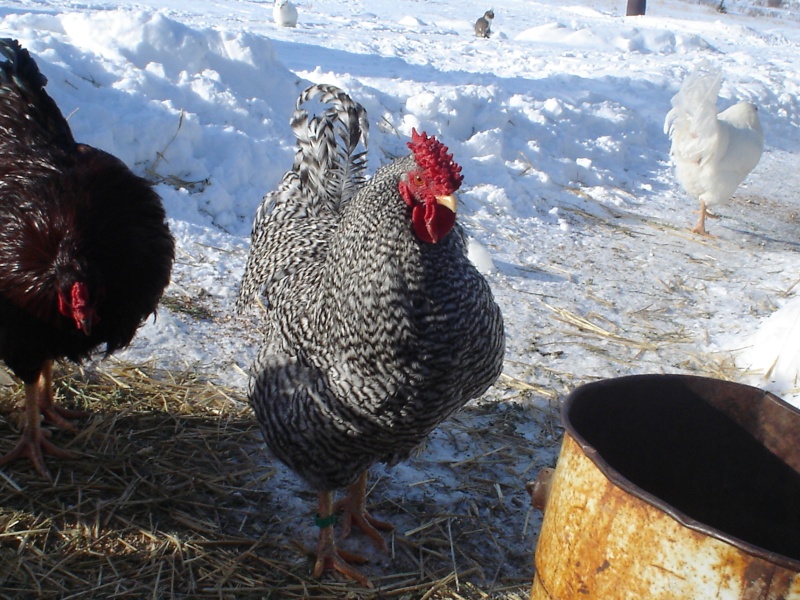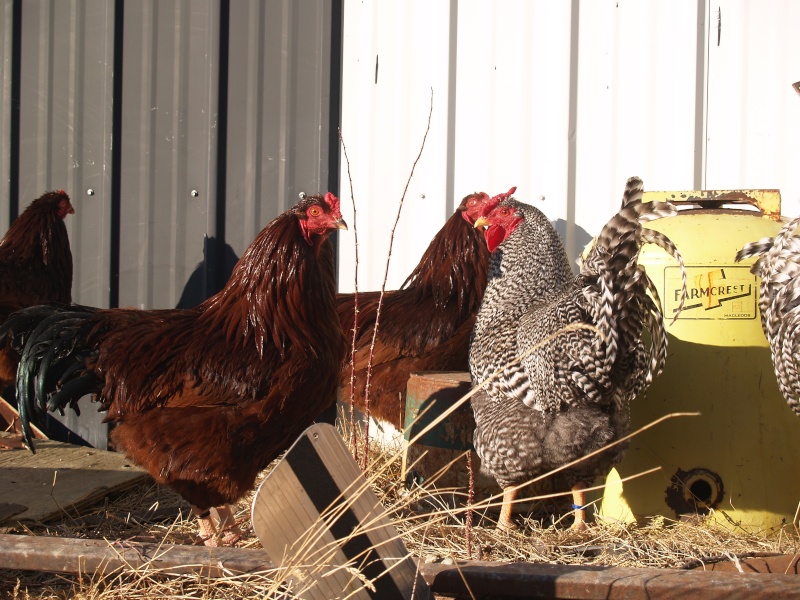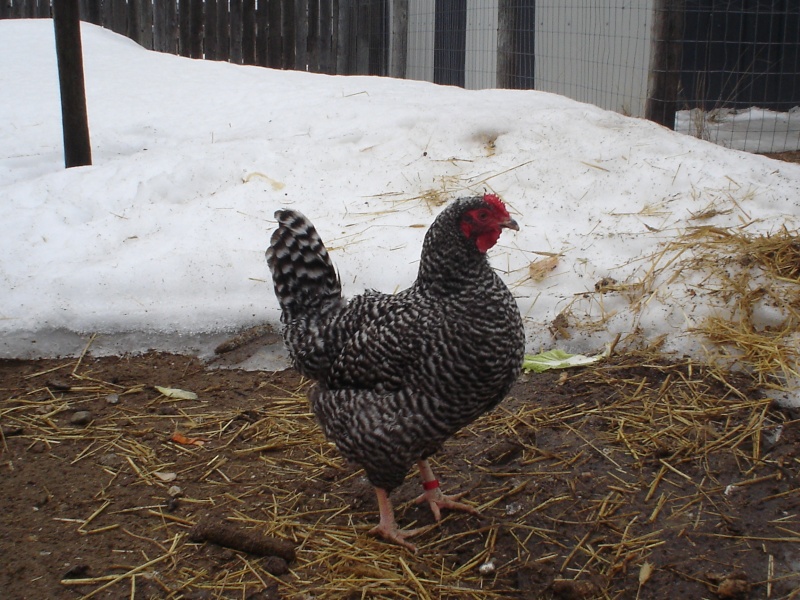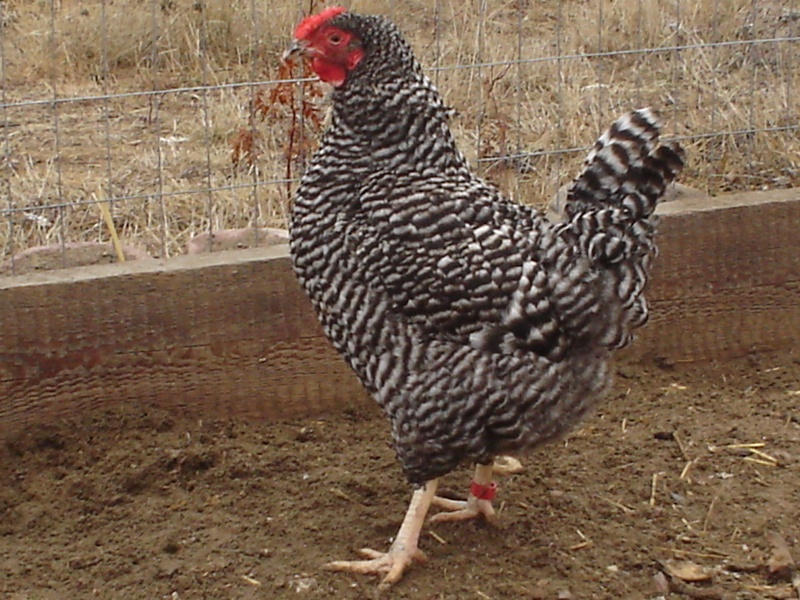An excerpt from an article that I thought you might find interesting.
The Dominique
"These modern methods make me sick"
Thus spake old Biddy Dominick
"We used to please ourselves you bet,
Folks took what fresh eggs they could get,
But now we stay up half the night
and lay our eggs by Mazda light.
This culling also I protest,
I'm getting old, I want to rest.
Yet if in laying I grow lax
I'll be the next to get the axe."
- The Poultry Item (April 1921 issue)
For centuries they have been known as a hardy, low maintenance farm bird. The exact origins of the Dominique are hidden back in the years following the colonization of New England. They are almost certainly an amalgamation of various breeds and types but the exact mix will never be known although some suggestions have been made regarding their parentage. Various possible ancestors have been suggested, such as the Cuckoo Dorking, the Scots Grey and/or some sort of Hamburg but this has been based on nothing more than a few known facts; all of these breeds are old enough to have sired the Dominique, having been in Britain they could have made their way to the early American Colonies (although we cannot be sure) and they each possess certain characteristics that also mark the Dominique. Another theory is that they may have arisen from stock brought over with the Puritans.
Part of the Dominique’s charm is that noone decided to create a breed that had certain characteristics or looked a certain way as was done with the composite breeds (such as the Plymouth Rock) or with some ornamental birds. The colonists had whatever chickens they had brought with them and they bred them however it was convenient. The hardiest birds survived and the best producers were bred and through this system a dual purpose barred fowl emerged.
The earliest records indicate that this bird was well known prior to 1750 and had always occurred in both rose and single-comb types. They were known by a variety of names, depending upon the time and place, such as Dominickers, Plymouth Rocks, Pilgrim Fowls, or Hawk-coloured Fowls. The productivity of these birds was steadily improved and, although the Dominique was never commercially important, they enjoyed tremendous popularity on the farm and was the only American breed that possessed enough distinct characteristics to entitle it to a name right up until the mid-1800's.
It was around this time the breed as a whole received a series of devastating blows. The Asiatic and Mediterranean breeds arrived in the Americas and began to be kept in large numbers. Then, through a variety of crosses between stocks, several highly productive composite breeds arose and took up residence in many farmyards. Older breeds, like the Dominique, simply could not match the productivity of these newcomers and were replaced. Finally, in 1870, the management of the New York State Poultry Show decided that only medium size rose-comb birds could compete as Dominiques, the large single-combed birds would be considered Plymouth Rocks and the small ones would be referred to as Dominique Leghorns. This ruling was upheld on January 15, 1871, when a group convened to formalize the breeds to be accepted into the “Standard of Excellence” (later to be known as the Standard of Perfection) and voted that the Dominique would only be recognized as a rose-combed variety. This despite the fact that the single-combed Dominique was, at the time, the more popular and more numerous of the two and that some individuals believed it to be the original type. By the end of that day the Dominique population had plummeted as the vast majority of them had been merged with the Plymouth Rock. This had been a political move as some members no longer favoured the old breeds and believed that they should make way for the newer varieties, as one member, Colonel Weld, stated regarding the Standard, ". . . we must not multiply breeds too much. It is bad enough to put Dominiques in."
Lewis Wright stated, in 1872, that the Dominique “in its native homeland has been of late comparatively neglected, owing to the preference of imported stock of all kinds”. He also wrote that it was already much more difficult to find in America than it had been only a decade before and that “many of the old strains have become crossed and tainted in blood”. Some specimens had made their way to England and he thought them to be “one of the most generally useful all-round fowls we know”. Unfortunately the Dominique, being yellow skinned, was not popular in English markets and the British population was eventually lost.
By the 1900's the bird was in a sharp decline and in very real danger of extinction. The American Poultry Association realized this and a push was made to rescue the breed starting with the formation of the National American Dominique Club. Three individuals, Carter, Davenport and Harwood, were the driving force behind the undertaking and they managed to find several pure strains of the original type. Through their efforts at breeding and showing, the bird began to recover during the period from 1900-1920. Unfortunately when these men passed away so did the effort, the club ceased to be and the bird’s population resumed its drop.
As unlikely as it might sound, the Great Depression and the war years did give the Dominique a respite as necessity temporarily increased the demand for hardy, low-input, production birds. However, following WWII intensive agriculture was taking off and many older breeds were being replaced on the farm by the modern commercial hybrids. The Dominique continued its decline until, in 1970, there were only four individuals who continued to keep the breed, Carl Gallaher, Robert Henderson, Henry Miller, and Edward Uber. The bird had never been so close to disappearing forever, indeed there were those at the time who believed that it had already done so.
Fortunately this was not the case. Interested parties made contact with these breeders and began to promote the bird. They were later aided by no small effort from the American Livestock Breeds Conservancy in a campaign to increase awareness regarding the bird’s critically low levels. With such a small population, inbreeding had become a concern and so a number of birds from four distinct strains were taken to the Sedgwick County Zoo, in Wichita, Kansas, where they were crossed in every possible combination for two generations. This stock was then released to the public where, in 1991, there was over 500 birds in the hands of private individuals and living history farms and museums. Today the Dominique is still listed as “critical” by the ALBC but has recovered enough that it is available from a few commercial hatcheries. This gives a person the opportunity to keep a bird that is not overly common but at the same time is not impossible to find.
Dominiques are good foragers that like to range (although they can take confinement well). The rose-comb lends itself to cold tolerance and will not easily freeze. The roosters weigh around 7 lbs and hens, 5 lbs, with a nice distribution of meat over the body. The chicks are dark grey with a yellow spot on the head and as adults the hens are usually darker than the roosters. The tail is carried high and the red comb and wattles are beautiful against the barred feathering. The Dominique also comes in bantam form.
Despite the efforts of a few short-sighted individuals who wanted to limit the Dominique to be a rose-combed variety, the bird’s genetics still recall a time when it was more variable in appearance. So it is that even today one will often find single combed chicks hatching from the rose-combed parents.
For me this is a bird that looks like it belongs in a farmyard. It is true that it is not capable of the levels of production seen in some other breeds and hybrids but, on the other hand, it does not require the large inputs that the high producers do. A large body, fast growth rate, and intensive egg laying all must be paid for with feed. Not so with the Dominique. It is not a bird of extremes. That is to say that it is not overly large or flashy or a tremendous producer of eggs or meat but rather all of these things are present in a sensible proportion such that it seems to exude an aura of simplicity and balance from bygone days.










